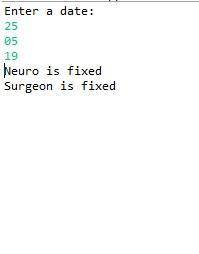
Computers and Technology, 22.04.2020 04:57 jesussanchez1445
Implement a superclass Appointment and subclasses Onetime, Daily, and Monthly. An appointment has the date of an appointment, the month of an appointment, the year of an appointment, and the description of an appointment (e. g., "see the dentist"). In other words, four major instant variables in these classes. Then, write a method occcursOn(year, month, day) that checks whether the appointment occurs on that date. Ensure to have a test program to test your classes. In your test program, you should create a list of appointments using the concept of polymorphism as your appointment pool. In other words, creating multiple objects using your subclasses of Onetime, Daily, and Monthly. Once you have those appointments available, allow the user to input day, month, and year to check whether the day of the month matches and print out the information of that matched appointment. For example, for a monthly appointment, you must check whether the day of the month matches. Have the user enter a date and print out all appointments that occur on that date.

Answers: 1
Another question on Computers and Technology

Computers and Technology, 21.06.2019 18:30
Ineed on my history if anyone can check out the last few questions i posted and i will be posting !
Answers: 2

Computers and Technology, 23.06.2019 09:30
The place where the extended axis of the earth would touch the celestial sphere is called the celestial
Answers: 1

Computers and Technology, 23.06.2019 19:30
What are loans to a company or government for a set amount of time
Answers: 1

Computers and Technology, 24.06.2019 14:40
Create a function (prob3_6) that will do the following: input a positive scalar integer x. if x is odd, multiply it by 3 and add 1. if the given x is even, divide it by 2. repeat this rule on the new value until you get 1, if ever. your program will output how many operations it had to perform to get to 1 and the largest number along the way. for example, start with the number 3: because 3 is odd, we multiply by 3 and add 1 giving us 10. 10 is even so we divide it by 2, giving us 5. 5 is odd so we multiply by 3 and add one, giving us 16. we divide 16 (even) by two giving 8. we divide 8 (even) by two giving 4. we divide 4 (even) by two giving 2. we divide 2 (even) by 2 to give us 1. once we have one, we stop. this example took seven operations to get to one. the largest number we had along the way was 16. every value of n that anyone has ever checked eventually leads to 1, but it is an open mathematical problem (known as the collatz conjectureopens in new tab) whether every value of n eventually leads to 1. your program should include a while loop and an if-statement.
Answers: 3
You know the right answer?
Implement a superclass Appointment and subclasses Onetime, Daily, and Monthly. An appointment has th...
Questions


Mathematics, 13.11.2020 22:50



English, 13.11.2020 22:50





Mathematics, 13.11.2020 22:50

Mathematics, 13.11.2020 22:50


Social Studies, 13.11.2020 22:50

Chemistry, 13.11.2020 22:50

Mathematics, 13.11.2020 22:50

Spanish, 13.11.2020 22:50

English, 13.11.2020 22:50







